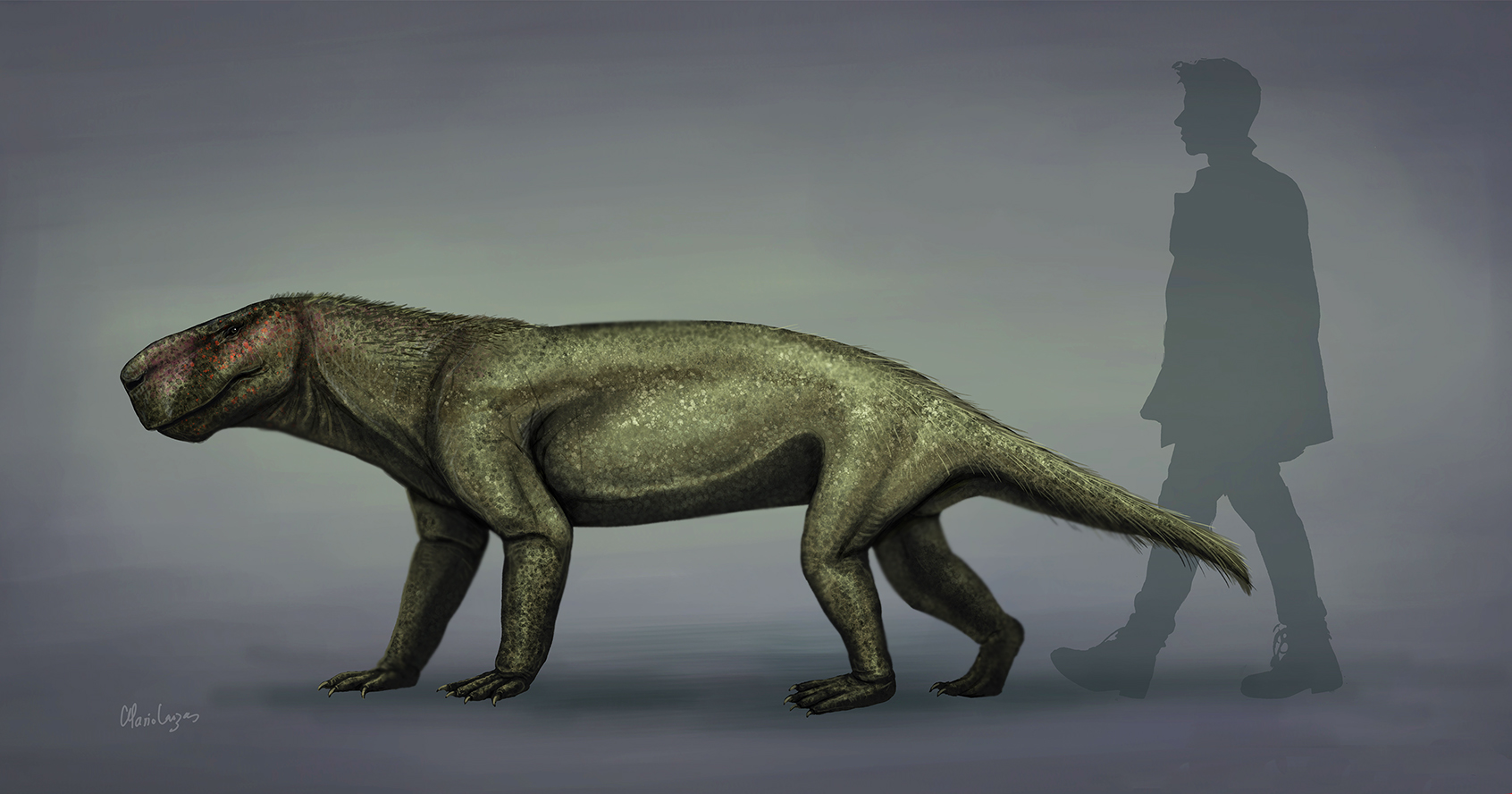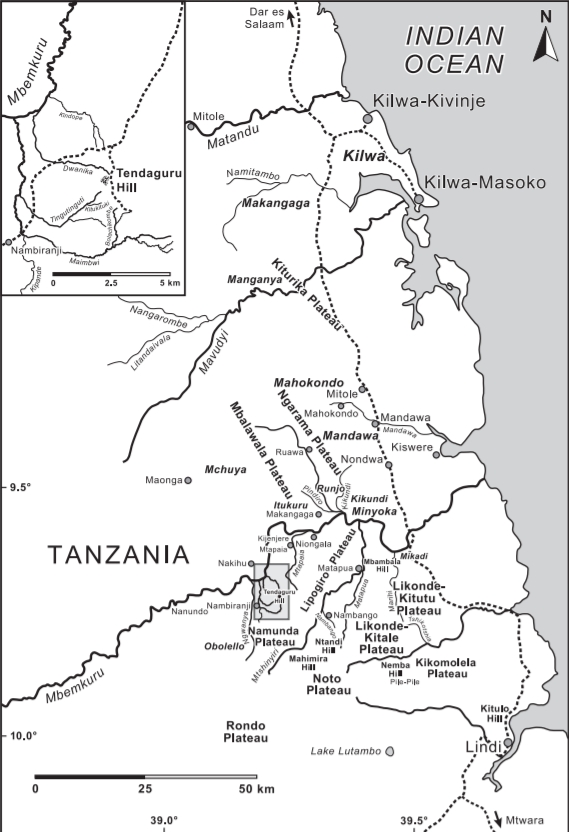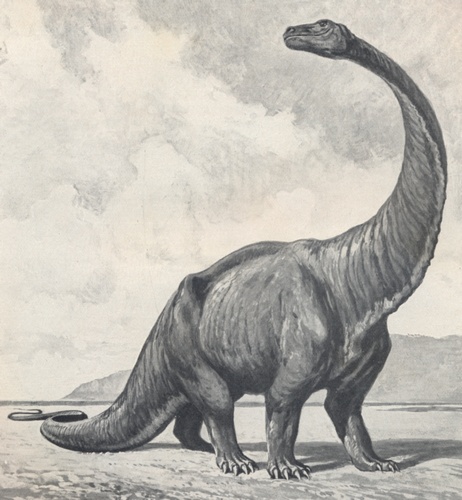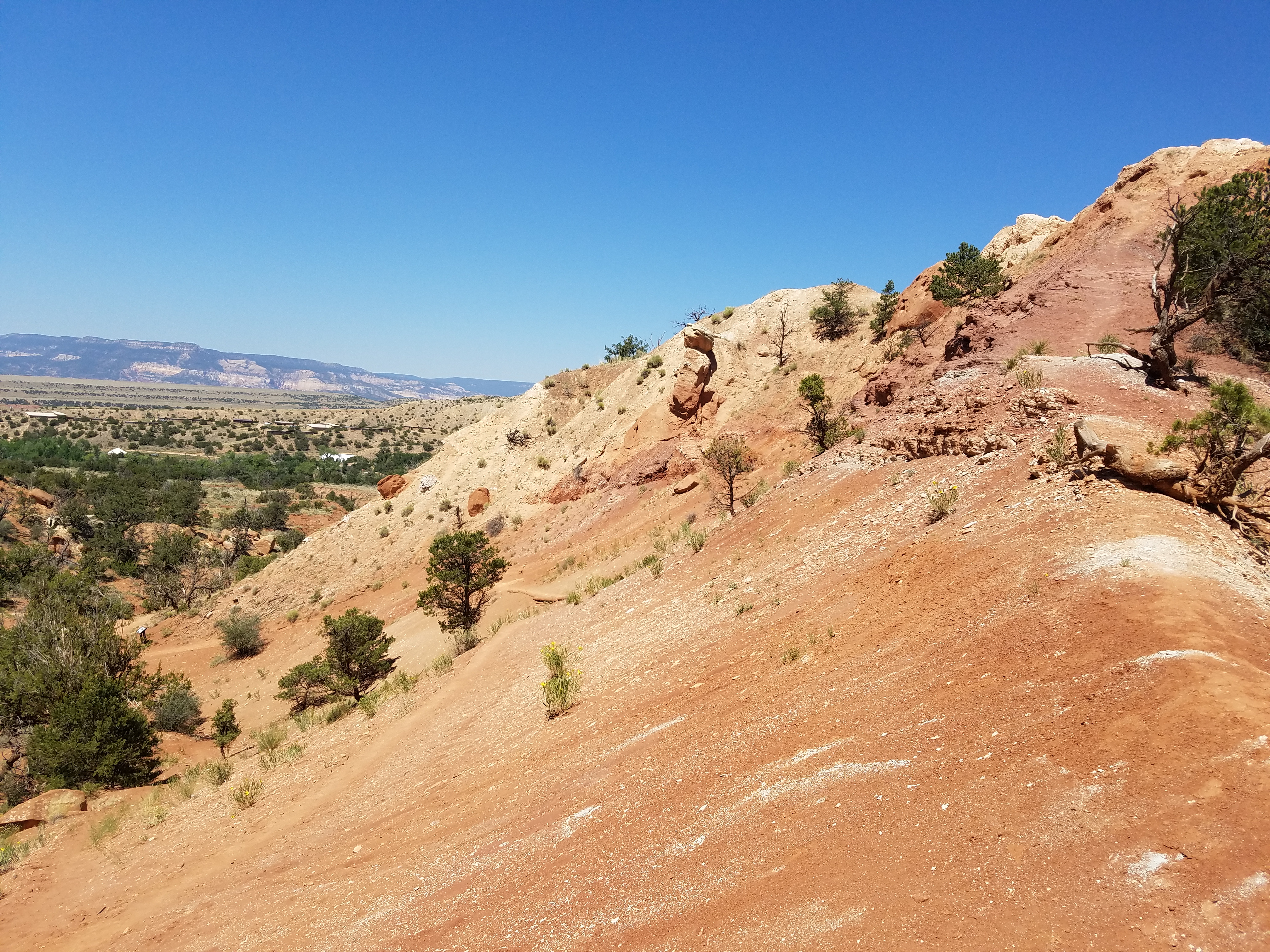|
Clarens Formation
The Clarens Formation is a geological formation found in several localities in Lesotho and in the Free State, KwaZulu-Natal, and Eastern Cape provinces in South Africa. It is the uppermost of the three formations found in the Stormberg Group of the greater Karoo Supergroup rocks and represents the final phase of preserved sedimentation of the Karoo Basin. Geology The Clarens Formation is composed nearly entirely of fine to medium-grained, thickly-bedded sandstones that range from pale orange or pinkish to cream in color. It is characterized by its remarkable gross lithological uniformity and that its deposits mainly outcrop as high cliffs. These Clarens Formation cliffs frequently contain shallow caves and overhangs at the contact of the underlying Upper Elliot Formation (UEF) due to processes of erosion. This particular feature of the Clarens Formation lead to the initial naming of these rocks the “Cave Sandstone” in older literature. It is thought that the geographical ra ... [...More Info...] [...Related Items...] OR: [Wikipedia] [Google] [Baidu] |
Arctognathus Curvimola
''Arctognathus'' is an extinct genus of Gorgonopsia, gorgonopsids that throve during the Late Permian in the Karoo Supergroup, Karoo basin of what is now South Africa. Discovery A carnivore, like all gorgonopsid, ''Arctognathus'' was given its name ("Bear jaw") in reference to its short and rounded snout. There is only one recognized species, ''A. curvimola''. Description It was a small gorgonopsid with a total length estimated at 1.1 m and an 18 cm skull. Classification Below is a cladogram from the phylogenetic analysis of Gebauer (2007): See also * List of therapsids References Bibliography * * Gorgonopsia Prehistoric therapsid genera Lopingian synapsids of Africa Fossil taxa described in 1911 Taxa named by Robert Broom Lopingian genus first appearances Lopingian genus extinctions {{paleo-therapsid-stub ... [...More Info...] [...Related Items...] OR: [Wikipedia] [Google] [Baidu] |
Gorgonopsia
Gorgonopsia (from the Greek Gorgon, a mythological beast, and 'aspect') is an extinct clade of Saber-toothed predator, sabre-toothed therapsids from the Middle Permian, Middle to the Upper Permian, roughly between 270 and 252 million years ago. They are characterised by a long and narrow skull, as well as elongated upper and sometimes lower canine teeth and incisors which were likely used as slashing and stabbing weapons. Postcanine teeth are generally reduced or absent. For hunting large prey, they possibly used a bite-and-retreat tactic, ambushing and taking a debilitating bite out of the target, and following it at a safe distance before its injuries exhausted it, whereupon the gorgonopsian would grapple the animal and deliver a killing bite. They would have had an exorbitant gape, possibly in excess of 90°, without having to unhinge the jaw. They markedly increased in size as time went on, growing from small skull lengths of in the Middle Permian to bear-like proportions of ... [...More Info...] [...Related Items...] OR: [Wikipedia] [Google] [Baidu] |
South Africa
South Africa, officially the Republic of South Africa (RSA), is the Southern Africa, southernmost country in Africa. Its Provinces of South Africa, nine provinces are bounded to the south by of coastline that stretches along the Atlantic Ocean, South Atlantic and Indian Ocean; to the north by the neighbouring countries of Namibia, Botswana, and Zimbabwe; to the east and northeast by Mozambique and Eswatini; and it encloses Lesotho. Covering an area of , the country has Demographics of South Africa, a population of over 64 million people. Pretoria is the administrative capital, while Cape Town, as the seat of Parliament of South Africa, Parliament, is the legislative capital, and Bloemfontein is regarded as the judicial capital. The largest, most populous city is Johannesburg, followed by Cape Town and Durban. Cradle of Humankind, Archaeological findings suggest that various hominid species existed in South Africa about 2.5 million years ago, and modern humans inhabited the ... [...More Info...] [...Related Items...] OR: [Wikipedia] [Google] [Baidu] |
Late Permian
Late or LATE may refer to: Everyday usage * Tardy, or late, not being on time * Late (or the late) may refer to a person who is dead Music * ''Late'' (The 77s album), 2000 * Late (Alvin Batiste album), 1993 * Late!, a pseudonym used by Dave Grohl on his '' Pocketwatch'' album * Late (rapper), an underground rapper from Wolverhampton * "Late", a song by Kanye West from ''Late Registration'' Other uses * Late (Tonga), an uninhabited volcanic island southwest of Vavau in the kingdom of Tonga * "Late" (''The Handmaid's Tale''), a television episode * LaTe, Oy Laivateollisuus Ab, a defunct shipbuilding company * Limbic-predominant age-related TDP-43 encephalopathy, a proposed form of dementia * Local-authority trading enterprise, a New Zealand business law * Local average treatment effect, a concept in econometrics * Late, a synonym for ''cooler'' in stellar classification See also * * * ''Lates'', a genus of fish in the lates perch family * Later (other) Later may ref ... [...More Info...] [...Related Items...] OR: [Wikipedia] [Google] [Baidu] |
Arctognathus
''Arctognathus'' is an extinct genus of gorgonopsids that throve during the Late Permian in the Karoo basin of what is now South Africa. Discovery A carnivore, like all gorgonopsid, ''Arctognathus'' was given its name ("Bear jaw") in reference to its short and rounded snout. There is only one recognized species, ''A. curvimola''. Description It was a small gorgonopsid with a total length estimated at 1.1 m and an 18 cm skull. Classification Below is a cladogram from the phylogenetic analysis of Gebauer (2007): See also * List of therapsids This list of therapsids is an attempt to create a comprehensive listing of all Genus, genera that have ever been included in the Therapsida excluding mammals and purely vernacular terms. The list includes all commonly accepted genera, but also gene ... References Bibliography * * Gorgonopsia Prehistoric therapsid genera Lopingian synapsids of Africa Fossil taxa described in 1911 Taxa named by Robert Broom Loping ... [...More Info...] [...Related Items...] OR: [Wikipedia] [Google] [Baidu] |
Tendaguru Formation
The Tendaguru Formation, or Tendaguru Beds are a highly List of fossiliferous stratigraphic units in Tanzania, fossiliferous Lithostratigraphy, formation and Lagerstätte located in the Lindi Region of southeastern Tanzania. The formation represents the oldest sedimentary unit of the Mandawa Basin, overlying Neoproterozoic basement (geology), basement, separated by a long hiatus and unconformity. It reaches a total sedimentary thickness of more than . The formation ranges in age from the late Middle Jurassic to the Early Cretaceous, Oxfordian (stage), Oxfordian to Hauterivian stages, with the base of the formation possibly extending into the Callovian. The Tendaguru Formation is subdivided into six members; these are from oldest to youngest the Lower Dinosaur Member, the ''Nerinella'' Member, the Middle Dinosaur Member, the ''Indotrigonia africana'' Member, the Upper Dinosaur Member, and the ''Rutitrigonia bornhardti-schwarzi'' member. The succession comprises a sequence of sandst ... [...More Info...] [...Related Items...] OR: [Wikipedia] [Google] [Baidu] |
Late Jurassic
The Late Jurassic is the third Epoch (geology), epoch of the Jurassic Period, and it spans the geologic time scale, geologic time from 161.5 ± 1.0 to 143.1 ± 0.8 million years ago (Ma), which is preserved in Upper Jurassic stratum, strata.Owen 1987. In European lithostratigraphy, the name "Malm" indicates rocks of Late Jurassic age. In the past, ''Malm'' was also used to indicate the unit of geological time, but this usage is now discouraged to make a clear distinction between lithostratigraphic and geochronologic/chronostratigraphic units. Subdivisions The Late Jurassic is divided into three ages, which correspond with the three (faunal) stages of Upper Jurassic rock: Paleogeography During the Late Jurassic Epoch, Pangaea broke up into two supercontinents, Laurasia to the north, and Gondwana to the south. The result of this break-up was the emergence of the Atlantic Ocean, which initially was relatively narrow. Life forms This epoch is well known for many famous types of d ... [...More Info...] [...Related Items...] OR: [Wikipedia] [Google] [Baidu] |
Tornieria
''Tornieria'' ("for Gustav Tornier, Tornier") is a genus of diplodocid sauropod dinosaur from the Late Jurassic in Lindi Region of Tanzania. It has a convoluted taxonomy, taxonomic history. Discovery and naming In 1907, German paleontologist Eberhard Fraas who was working the Tendaguru Formation, Tendaguru Beds in German East Africa (presently Tanzania), discovered two sauropod specimens at a single site ("Quarry A"). The two individuals, designated "Skeleton A" and "Skeleton B", each represented a different sauropod species. In 1908 he named these respectively ''Gigantosaurus africanus'' ("African giant lizard") and ''G. robustus'' ("Robust giant lizard"). A third, unrelated African species, "Gigantosaurus" ''dixeyi'', was named by in 1928, and has since been reassigned to ''Malawisaurus''. However, the name ''Gigantosaurus'' had already been used for the European sauropod ''Gigantosaurus megalonyx'' Seeley, 1869. Fraas, not intending to place his species in the same genus as ... [...More Info...] [...Related Items...] OR: [Wikipedia] [Google] [Baidu] |
Coelophysis
''Coelophysis'' ( Traditional English pronunciation of Latin, traditionally; or , as heard more commonly in recent decades) is a genus of coelophysid Theropoda, theropod dinosaur that lived Approximation, approximately 215 to 201.4 million years ago during the Late Triassic Period (geology), period from the middle Norian to Rhaetian age in what is now the southwestern United States. ''Megapnosaurus'' was once considered to be a species within this genus, but this interpretation has been challenged and the genus ''Megapnosaurus'' is now considered valid. ''Coelophysis'' was a small, slenderly built, ground-dwelling, bipedal carnivore that could grow up to long. It is one of the earliest known dinosaur genera. Scattered material representing similar animals has been found worldwide in some Late Triassic and Early Jurassic formations. The type species ''C. bauri'', originally given to the genus ''Coelurus'' by Edward Drinker Cope in 1887, was described by the latter in 1889. T ... [...More Info...] [...Related Items...] OR: [Wikipedia] [Google] [Baidu] |
Portland Formation
The Portland Formation is a geological Formation (geology), formation in Connecticut and Massachusetts in the northeastern United States.Portland Formation - USGS It dates back to the Early Jurassic period.Weishampel et al., 2004, pp.530–532 The formation consists mainly of sandstone laid down by a series of lakes (in the older half of the formation) and the floodplain of a river (in the younger half). The sedimentary rock layers representing the entire Portland Formation are over thick and were formed over about 4 million years of time, from the Hettangian age (lower half) to the late Hettangian and Sinemurian ages (upper half).Olsen, P.E. (2002). In 2016, the paleontologist Robert E. Weems and colleagues suggested the Portland Formation ... [...More Info...] [...Related Items...] OR: [Wikipedia] [Google] [Baidu] |






